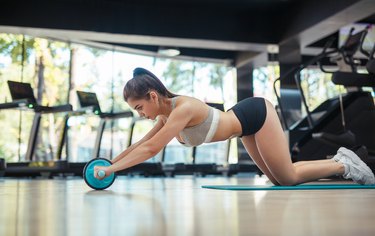
The array of exercise machines at the average gym can be dizzying. Learning which machines work which muscles — and how to use them — can seem almost impossible as a beginner. Keep it simple. You can get an effective workout for your lower abs with three gym machines for abs found in almost every gym.
Tip
There are only a few machines at the gym that work your abs exclusively. Learn how to use them properly so you can tighten your lower abs.
Video of the Day
Work Your Abs Together
Many people think of the upper abs and lower abs as two different muscles, but they're not, according to exercise scientist Len Kravitz, PhD, writing for the University of New Mexico. Your abs are composed of the deep abdominal muscles, called the transverse abdominis, and the superficial or six-pack abs, called the rectus abdominis.
Video of the Day
Other muscles play roles too, including the obliques and intercostals. All abdominal exercises will work the upper and lower abs (parts of the same muscles); some exercises will put more emphasis on the lower or upper portions of your abs and some will work them both equally.
Seated Ab Crunch Machine
This is one of the few exercise machines specifically made to work the abs. That's its only purpose, and it works with the help of a weight stack that creates resistance. There are different styles of ab crunch machines; some have a padded bar across your chest, while others have handles that you grip. They both work in pretty much the same way.
How to Use It:
- Sit on the seat of the machine and slide your buttocks back all the way into the seat. Firmly press your back against the back pad.
- Adjust the weight stack. Start with a light weight so you can get the feel of the movement, then increase the weight from there.
- Adjust the padded chest bar, if there is one, so that it sits right about the level of your armpits. If there are handles above your head instead of the chest pad, grab hold of those.
- Contract your abdominal muscles by pulling your belly button in toward your spine as you push against the chest pad or pull the overhead handles, bringing your chest toward your knees. Only crunch as far as your back will allow — never overstretch your back muscles.
- Pause at the end of the movement, then return to the starting position with control.
Read more: The Science of Amazing Abs
Perform the Kneeling Cable Crunch
The hulking machine — often located in the center of the gym — with all the cables, pulleys and assorted weight stacks is called a cable machine. You can do an endless number of exercises on this machine, some of which will strengthen your abs. A simple cable crunch will target all of your abdominal muscles, including your lower abs.
How to Do It:
- Select the cable rope attachment for this exercise.
- Adjust the weight stack, starting out light to learn the movement.
- Get down on your knees on the floor in front of the weight stack. Keep your knees about hip-distance apart and sit down on your heels with your toes tucked under.
- Grasp either end of the cable rope with each hand and pull it down to the top of your head. Position your wrists against your head.
- Contract your abdominal muscles as you bend at the waist recommends ExRx.net, using your abdominal strength to round your back into a crunch position.
- Return to the starting position with control, resisting the weight of the cable.
Read more: How to Even Out Abdominal Muscles
Sit in the Captain's Chair
The captain's chair isn't a machine per se, but you'll usually find it on the gym floor in the same area as the weight machines. It has been touted by ACE Fitness as one of the ab exercises with higher muscle activation. It's a static piece of equipment with no moving parts and looks like a tall chair with no seat.
How to Do It:
- Position your forearms on the padded armrests and grip the handholds. Press your back into the back pad. Allow your legs to dangle below.
- Contract your abdominal muscles as you lift your knees up toward your chest in a slow and controlled manner.
- Straighten your legs with control to return to the starting position.